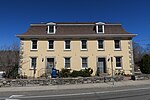Ashbel Woodward House
Franklin, ConnecticutHistoric house museums in ConnecticutHouses completed in 1835Houses in New London County, ConnecticutHouses on the National Register of Historic Places in Connecticut ... and 2 more
Museums in New London County, ConnecticutNational Register of Historic Places in New London County, Connecticut

The Ashbel Woodward House is a historic house museum at 387 Connecticut Route 32 in Franklin, Connecticut. The house is now operated by the Town of Franklin as the Dr. Ashbel Woodward House Museum. The house was built c. 1835, and is a fine local example of a Greek Revival house in a rural setting. It was home for many years to Ashbel Woodward, a local doctor. His descendants gave the property to the state in 1947. The house was listed on the National Register of Historic Places on April 8, 1992.
Excerpt from the Wikipedia article Ashbel Woodward House (License: CC BY-SA 3.0, Authors, Images).Ashbel Woodward House
Route 32,
Geographical coordinates (GPS) Address Nearby Places Show on map
Geographical coordinates (GPS)
| Latitude | Longitude |
|---|---|
| N 41.604722222222 ° | E -72.136666666667 ° |
Address
Route 32 387
06254
Connecticut, United States
Open on Google Maps










